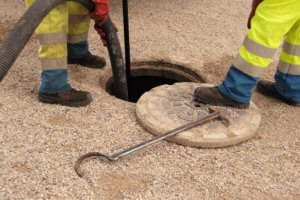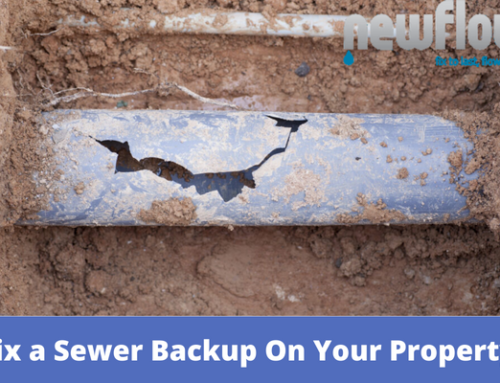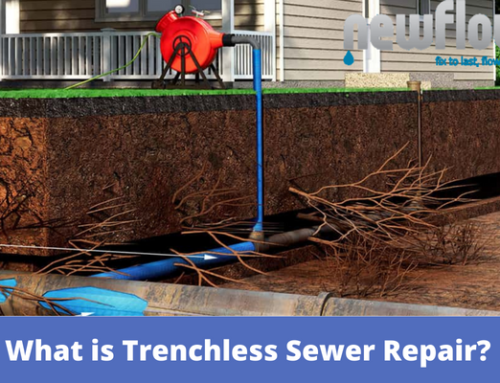Is your sewer backing up?
If you notice strange signs with your plumbing, and simply plunging or snaking the drain doesn’t work, what could be the real problem? It may be damaged sewer lines that are the true source and origin of the backup. What are some signs you should look for that mean your sewer line is failing, or has already failed?
Look out for these.
- Blockage – If all of your toiles and drains in your house show signs of backup, it is most likely your main sewer line that’s affecting them.
- Odor – If you can smell a horrible, nasty, sewer smell in your home, chances are there is a crack in the pipe, and gas is leaking.
- Mold – If there is a break in your sewer line, gases will escape as well as heat. The increase in humidity in your walls and floors are the perfect conditions for mold growth.
A plunger or drain snake may not be able to fix a sewer backup. So who is responsible then?
4. Slow drains – A slow drain is a clear sign that something is blocking the line and will lead to sewage backup. One possible solution could be just cleaning the drains, but the damage could be larger and further up the line.
5. Backyard signs – If sewage is leaking into your yard, areas of your grass will seem extra green and growing. Sewage acts as a fertilizer and your grass will become mismatched and uneven. You may also notice dips and small valleys due to the soil sinking into the pipe. Septic water may leak into your yard making it unbearable to breathe.
6. Major home issues – Believe it or not, your home’s foundation can settle and crack if left untreated. You do not want that! If this becomes the case, immediately call a foundation repair specialist.
7. Infestation – Because the pipe may be cracked, small creatures can find their way into your home. Rats, mice, cockroaches, palmetto bugs, and sewer flies can invade your personal space. A simple sewer CCTV inspection can find where they are entering from.
When is the city responsible for sewer backups?
Cities and municipalities are responsible for any problems with the public sewer main. There are main blockages to the city sanitary system that will cause problems, like fatbergs (a rock-like mass of waste matter in a sewer system formed by the combination of flushed non-biodegradable solids, such as wet wipes, and congealed grease or cooking fat.) If this is the case, then it will be the responsibility of the city.
When is the city responsible for sewer backups? Are they the ones who pay?
The main sewer line carries waste away from homes and can cause sewer backups with relative ease due to clogs. Although the city will be accountable for problems starting at the main underground sewer pipe, homeowners are responsible for plumbing repairs for the pipes running to the main line.
Read more about: How do you know if your insurance covers sewer line repair?
When are you responsible for sewer backups?
More likely than not, the city is not held responsible for plumbing and sewer repairs on residential property. It is very important that you inspect your sewer lines when purchasing a new home, so as to see the current life-use of the pipes. Using a CCTV sewer camera inspection, which New Flow Plumbing offers, you can discover if the issue does begin with the public sewer main or your sewer line.
Have you ever heard of sewer laterals? What are they, and why is the homeowner responsible for them?
What are sewer laterals?
Sewer laterals are underground pipes that connect your home wastewater to the main sewer line beneath the street. You are responsible for the sewer laterals, while problems to the public main sewer line are managed by the city.
There are two types of sewer laterals.
Upper laterals
The upper lateral is the section of pipe that runs from your home to your property line. Your property line usually stops at the curb or sidewalk.
Lower laterals
Lower laterals are section of residential plumbing that runs from the property line to the public sewer main line in the street. Many homeowners assume the lower lateral is not their responsibility. This is not the case. In most situations, it is the residential property owner who must maintain and repair the lower lateral piping.
The city or local municipality is only responsible for the public main sewer line.
So how can you fix a backed up or damaged sewer line? The answer is trenchless sewer repair!
Trenchless sewer repair: How New Flow Plumbing helps
Trenchless sewer repair is a cost-effective, fast, and non-invasive solution to replacing sewer lines. The conventional and outdated method, involves digging and trenching your home. Not good!
It is the homeowners responsibility to fix residential plumbing issues, but New Flow Plumbing is happy to help.
So you can see how trenchless has become the go-to solution and most requested repair method. Trenchless sewer repair is broken up into two methods.
1. Pipe Lining
Also called structural pipe lining, or cured-in-place lining (CIPP), sewer pipe lining involves a special, epoxy-impregnated liner to create a new pipe directly inside your old one. CIPP is designed to last up to 50 years!
We perform a CCTV inspection to see what’s going on in the pipe. If it is not falling apart and maintains its structural integrity, we can line the pipe. Then we use hydro-jetting to clear out any debris. Next involves the actual lining.
We find two access points and feed in a felt liner (cut for the pipe’s dimensions) saturated with a special epoxy and then insert it into the damaged pipe. A bladder inside the liner is inflated and pushes the epoxy against the walls of the pipe. After the epoxy cures, the bladder is removed, and you now have a brand new pipe within your old one.
2. Pipe Bursting
We perform a CCTV sewer camera inspection and see how the pipe is holding up. Next, we find our two access points, one on each end of the pipe typically in your yard. The brand new HDPE (high-density polyethylene) pipe is attached to a winch with a cone-shaped bursting head and pulled through the damaged pipe.
The damaged pipe is broken apart as the new pipe takes its place. We perform another CCTV inspection to ensure everything is completed and then fill in any pits or reinstall any fixtures we removed.
Both are cost-effective with pipe bursting being more favorable. Whatever your problem, we at New Flow Plumbing will assess the situation using a CCTV sewer camera inspection and give you the best solution. Contact us today and receive a quote!








